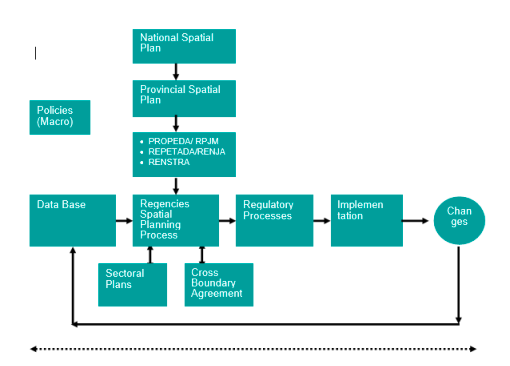Difference between revisions of "3. Analysis of coastal spatial plans"
(Tag: Visual edit) |
(Tag: Visual edit) |
||
| Line 19: | Line 19: | ||
[[File:Planning as a dynamic and cyclical process.png|center|thumb|550x550px|Planning as a dynamic and cyclical process]] | [[File:Planning as a dynamic and cyclical process.png|center|thumb|550x550px|Planning as a dynamic and cyclical process]] | ||
| − | '''3.1 Coastal Management Plans''' | + | '''[[3.1 Coastal Management Plans]]''' |
| − | '''3.2 National Spatial Plan''' | + | '''[[3.2 National Spatial Plan]]''' |
'''3.3 Java and Bali Island Spatial Plan''' | '''3.3 Java and Bali Island Spatial Plan''' | ||
Revision as of 05:56, 29 September 2021
Spatial plans in Indonesia are the product of the planning system in Indonesia which is mostly centralized and known for hierarchical planning. The system is inspired by a balanced development concept in the sense that national income will be distributed according to the central government strategic plan to promote equal distribution of socio-economic development throughout the nation. The legal basis for the system is the Law No. 26, 2007, Undang-Undang tentang Penataan Ruang (Law for the Republic of Indonesia on Spatial Planning).
This accommodates a spatial administrative allocation of geographical units based on resources endowment and functions such as protected area, cultivated area, rural and urbanized area. The spatial plan is used as a guideline for physical development, i.e. infrastructure, in urban and rural areas.
The hierarchical system starts at the National Spatial Plan (RTRN/Rencana Tata RuangNasional) as the top frame for the regional/provincial spatial plans). At the provincial level spatial planning works as frame for the lower level spatial plans, i.e. district/regency level and municipal level. In this system provincial/Regional Spatial Plan (RTRW/Rencana Tata Ruang Wilayah Propinsi) is a frame for the spatial plans of regencies and municipality (RTRW Kabupaten and RUTR Kota) within the province.
Amongst the planning instruments that the local agencies have spatial plans are considered the most comprehensive and popular because it aims to integrate all inter-boundary and inter-sectoral issues and land use demands for relevant sectoral development programs.
3.3 Java and Bali Island Spatial Plan
3.4 Provincial Spatial Plan
3.5 Strategic Environmental Assessment/Studies for Provincial Spatial Plan
3.6 RZWP3K (Coastal Area and Small Island Zoning Plan)
3.7 Strength and weakness of the Indonesian Spatial Planning


